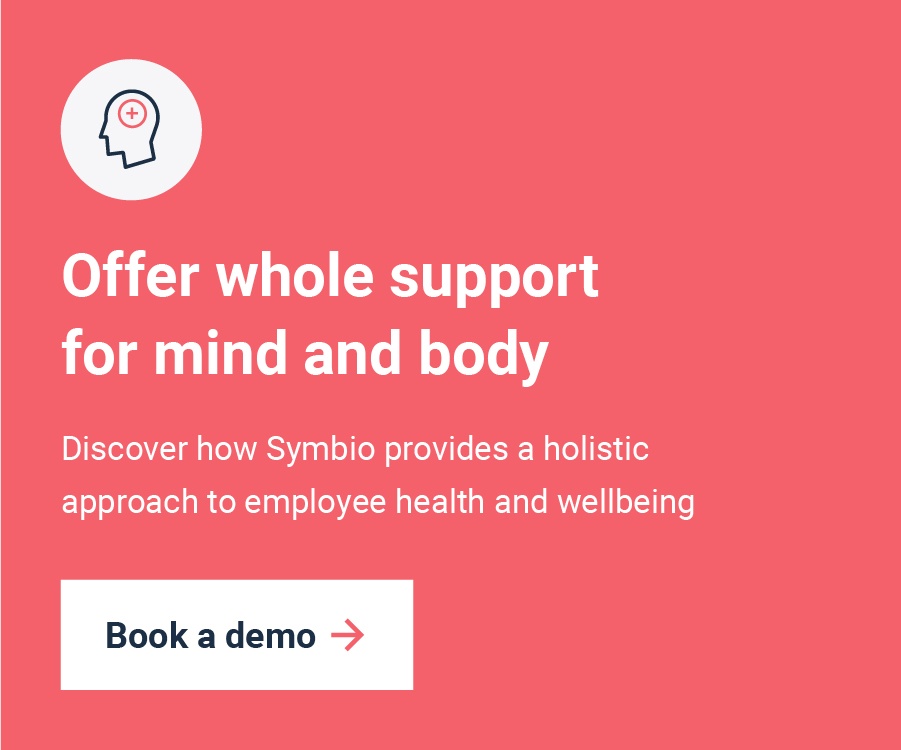Anxiety is the leading mental health issue globally. Hardly surprising, then, that anxiety and depression are estimated to cause 20 percent of lost work days in the UK.
In Britain, anxiety and depression (often found in a pair) are the most common mental disorders. Around 8 percent of people meet the criteria for a formal diagnosis.
This means if you lead a team of 25, at least two people could be struggling with persistent anxiety. In a company of 500, that could be 40 people coping with sustained anxiety at work. Supporting these people is part of the duty of care you owe to both your employees and the business:
- Supporting workers’ mental health could save businesses in the UK £8 billion annually.
- Places of work where mental wellbeing is high are more productive.
- Taking action on mental wellbeing improves productivity by as much as 12 percent.
The question is: how can you deliver this much-needed support? This blog explores the effects of anxiety on your workers and how to support them through it.
What do we mean by anxiety?
Anxiety is natural, of course. Employees might feel anxious when they vie for promotion, are assigned to an important presentation or embark on business travel. Your workers might also have personal circumstances that cause anxiety: moving house or having a new baby.
Anxiety is defined by the NHS as ‘a feeling of unease, such as worry or fear, that can be mild or severe’. According to Psychology Today, it can be a ‘mental and physical state of negative expectation’.
For some, though, anxiety isn’t a moment. A person’s worries extend to several situations or issues, often with disproportionate fears compared to the circumstances. This is a sign of sustained anxiety and a possible disorder. And when someone experiences sustained anxiety, it affects all areas of their life.
What causes sustained anxiety?
The circumstances that cause anxiety vary from person to person. Still, there are common threads. Certain events, situations or environments often cause anxiety or become the focus of an anxiety disorder. They include:
- Money problems. The cost-of-living crisis is having a big impact. This has made an existing worry for some much more acute. It has also significantly widened the range of people struggling, as even the basics have moved out of reach.
- Personal conflict. Difficulties with a spouse, another family member, a friend or a coworker can take an emotional toll. Left unresolved, the strain puts your employee in mental distress as they navigate the conflict.
- Substance misuse. Anxiety and substance abuse are sometimes co-occurring. Someone may use alcohol or another drug to alleviate their anxiety. But then, the thought of going without that crutch can cause greater anxiety.
- Work stress. An employee’s role can cause undue stress. This might be due to an excessive workload, inadequate support, poor work-life balance, a poor work environment or even the significant impact their responsibilities have on the company.
- Health issues. Severe and ongoing medical issues lead to anxiety either because of symptoms, the side effects of medication, the consequences for work and home life or its financial impact.
- Traumatic life events. A single traumatic event can have a massive aftershock. This can be especially true of childhood trauma or the sudden loss of someone close. It alters how your worker functions and perceives life.
- Lack of community. Sometimes, a move or change in life circumstances leaves a person isolated. This can be true for new parents or recently separated partners. It can also be a byproduct of the recent change to remote working. Loneliness is a known cause of mental health issues like anxiety.
Most causes of anxiety are part of the ebb and flow of life. But living with this constant dread takes a significant toll.
The effects of living with anxiety
Everyone will go through hardships, but those with an anxiety disorder live in fear of constant hardships. They see the everyday evolving into worst-case scenarios, sure the next challenge is around the corner.
A person with anxiety can be affected physically and mentally. It can seep into their life, affecting their social life, work and the people around them. Some of these effects include:
Health issues. Anxiety causes dizziness, heart palpitations, nausea, sweating, shortness of breath and panic attacks. Other symptoms might include high blood pressure, headaches or digestive issues.
Sleep issues. Mind says anxiety causes thoughts to race and cycle. The worries from the day can keep your worker awake at night. This is also when panic attacks often occur.
Effects on the mind. Someone with anxiety can experience constant dread, irritability, difficulty concentrating, detachment, feeling on edge, and panic. This consumes a person’s thoughts, making it difficult to focus on their responsibilities.
Depression. Depression is often coupled with anxiety. According to Psychology Today, the two have similar symptoms and share brain pathways. Around half of the people with an anxiety disorder will also have depression.
Poor performance at work. Amid the cost-of-living crisis, 93 percent of managers and team leaders said the resulting stress affected employees’ productivity. When your mind is occupied with worry, it makes sense it would impact work performance.
Substance misuse. Living with constant fear and worry can make people want to dull those plaguing thoughts. Some may turn to drugs or alcohol for a reprieve, leading to further complications and side effects.
Issues in personal relationships. Anxiety affects personal relationships. It can cause excessive dependence or avoidance, especially when the swirling thoughts focus on people. This can lead to unhealthy relationships or isolation, which can perpetuate anxiety.
The similarities between the causes of anxiety and its effects are all too apparent. And it shows the vicious cycle in which people with sustained anxiety are often trapped. That is until they get support.
How to help your workers and support them through anxiety
Supporting colleagues with anxiety is the right thing to do. It’s also sensible. Anxiety can easily affect focus, communication, work relationships, productivity and quality of work.
So, how do you go about helping those in your organisation who are stuck in an anxiety spiral? What kind of support is possible in your workplace, financially and logistically?
Let’s talk about what support in the workplace looks like if your company and its line managers step up to support employees who battle anxiety.
Create connection
Did you know? ‘Perceived isolation’ puts people at risk of anxiety (and depression). And social connections and involvement are associated with better mental health.
So, how do you deter isolation and improve connection? You might have more power than you think:
- Line managers can have an open-door policy.
- You can initiate mentorship programs, shared interest groups or social events to bring people together.
- You might consider supporting a cause as a group.
- Connection can even be made through simple changes like using messaging platforms, a recognition program or more collaboration in your work.
These small changes create workplace connections that can reduce perceived (or real) isolation. These are building blocks to a workplace culture known for connection. And it benefits those in your company struggling with anxiety.
Encourage conversation
Mental health is no longer the taboo it once was in the workplace. The number of people who say they have had conversations at work about mental health increased dramatically from 2019 to 2021. A pandemic ushered in this openness. But it will require intentionality for the conversation to continue.
To maintain a supportive and safe space, you can:
- Ensure employees know they can talk to their line manager through an open-door policy.
- Conduct mental health surveys to stay in touch with employee wellbeing in your company.
- Appoint a health officer to help shape policies to support those with anxiety and for other wellbeing initiatives.
- Provide access to health professionals for practical help through an app like Symbio.
- Create a channel on your messaging platform dedicated to sharing mindfulness practices.
- Host mindfulness or meditation sessions to help employees decompress from stress.
There are many ways to encourage the conversation around mental health and anxiety. The key is to take action now. It’s easier to keep momentum than it will be to break the silence.
Signpost employees to resources
Part of the conversation around mental health and anxiety is education. You can develop or identify resources on anxiety and share them with your employees. This both creates awareness and offers support to those who need it most.
Resources may come in the form of a newsletter or intranet page. Perhaps a team email or time to share in a meeting would work. It could also be an app like Symbio, which connects employees to articles and resources, including mental health professionals.
Whatever channel works for your organisation or team, providing resources to employees encourages open communication. It’s critical to let employees know the support is available and put it directly into their hands.
Consider working conditions
Anxiety can stem from the workplace itself. People are found to be most affected by their workload and line managers. But a lack of work-life balance, the type of work or interpersonal relationship issues could also be a source of anxiety. Additionally, stressful working conditions are shown to exacerbate mental health issues.
Yet only 50 percent of managers have received training to support workers, and just 37 percent are trained to spot warning signs, according to a CIPD survey. Left unchecked, sustained anxiety leads to issues like presenteeism, leavism or lowered productivity. So these issues have a significant impact on your business.
The solution is to make changes and offer support to those whose anxiety is caused by work. Companies and line managers can train to notice employees experiencing stress or anxiety. They can also build positive work culture, hone time off policies, adjust workloads, and pay attention to work-life balance.
Offering support in the workplace means taking a serious look at your company. Practical changes could ease anxiety and support workers more than any other initiative.
Offering support to those with anxiety
Anxiety can affect anyone at different times and in different ways. Some of your workers are most likely, right now, distracted by constant feelings of dread.
Those struggles affect their wellbeing and their work. And it makes sense for companies to support their people through those struggles.
Interested in what a resource like Symbio could do to support your company’s workers? It provides resources on anxiety and gives access to healthcare professionals who can help employees manage anxiety. Book a demo today.





